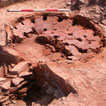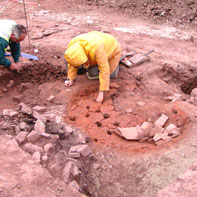Roman Craft and industry
One of the things that marks out the Roman period archaeologically is the number of material possessions that can be found on sites which were occupied at this time. We do not find so much again until the 18th century. There was a big increase from the Iron Age in the amount of manufacture that was being carried out, although the Romans never developed the large-scale factory production we see during the Industrial Revolution.
Roman objects have been found in the lead mines at Goldsland Wood near Barry and Draethen near Caerphilly, showing that these deposits were being exploited. The ores from the Draethen mine also contain significant amounts of silver, so they would have been an imperial monopoly. Lead processing was probably being carried out at Lower Machen.
Our area is also rich in iron, and on some sites the remains of Roman iron-smelting furnaces have been found, together with dumps of the slag they produced. The Miskin area seems to have been one place where iron-smelting was important. An iron furnace has been found at Cowbridge, and small-scale smelting also went on in the settlement outside the fortress at Caerleon. Once the pig-iron had been produced, it was worked by blacksmiths to produce tools, weapons and fittings. The iron ingots still contained lumps of slag that had to be eliminated during this process, and most settlement sites produce this ‘smithing slag’. This shows us that either craftsmen who lived in all these settlements were able to produce iron objects, or there were travelling blacksmiths who went the rounds.
Pots had become very much more important for everyday use. Many of the greyware cooking and storage dishes and pots found in our area were made fairly locally, as at the kilns excavated at Caldicot in the 1960s. Other kilns excavated at Bulmore were making redwares for the table.
These industries, although small-scale in comparison with those of more recent times, have left behind characteristic structures such as kilns. For other crafts, only some of the smaller equipment and tools have been found. For example, copper alloys were used not only for kitchen equipment and costume jewellery, but also for the type of small mouldings that might nowadays be made in plastic. Crucibles with traces of copper have been found on some sites, showing that these things were being made locally. Tools used by masons, plasterers, carpenters and leatherworkers are all commonly found on Roman sites. Spinning and weaving would have been very important for the manufacture of clothes and other textiles, but it was carried out in the home with equipment mainly made from wood, so usually only the weights from the spindles survive.

